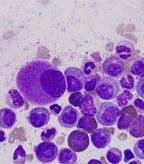Common Genetic Mutation Confers TKI Resistance in CML
A common genetic mutation in BIM appears to play a role in resistance to tyrosine kinase inhibitors in chronic myeloid leukemia (CML) and EGFR-mutated NSCLC.
A common genetic mutation appears to play a role in resistance to tyrosine kinase inhibitors among certain types of cancer, including chronic myeloid leukemia (CML) and EGFR-mutated non–small-cell lung cancer (NSCLC), according to a new study.

A small, hypolobated megakaryocyte in a bone marrow aspirate, typical of chronic myelogenous leukemia; source: Difu Wu, Wikimedia Commons
Researchers led by King Pan Ng, of the National University of Singapore, identified an intronic deletion polymorphism in the BIM gene; the proteins this gene encodes are required for TKIs to induce cell death in cancer cells. The results of the study were published in Nature Medicine.
The investigators used parallel DNA sequencing to find the polymorphism; they studied samples from five CML patients, three of which were resistant to TKI treatment and two of which were sensitive to the drugs. The BIM polymorphism occurred in all of the TKI-resistant samples.
They then screened 2,597 healthy individuals and found the genetic mutation was relatively common in certain ethnic groups: 12.3% of East Asian individuals carry the polymorphism, but it was entirely absent in African and European populations.
The BIM mutation represents a “previously unidentified mechanism for TKI resistance,” according to the researchers. The protein responsible for regulating cell death-which is how TKIs fight cancer cells-is encoded on exon 4 of the BIM gene, and the newly identified mutation causes exon 3 to be spliced with exon 4. This results in proteins that lack the ability to regulate cell death.
To further test the result, CML cells with the polymorphism were treated with the TKI imatinib; these cells were less sensitive to imatinib-induced cell death than those without the mutation. Furthermore, the resistance to imatinib could apparently be overcome with ABT-737, an agent that mimics the specific cell death-regulating protein that BIM encodes.
These findings also suggested that the BIM deletion could be used as a biomarker for TKI treatment success, so the investigators retrospectively analyzed two East Asian CML cohorts of 203 total patients. Patients with the mutation were indeed more likely to have resistant disease. When taken together, patients in the two cohorts with the BIM deletion had an odds ratio for resistant disease of 2.94 (95% CI, 1.17-7.43; P = .02). No other significant predictors of treatment failure were found in these patients. Most resistant patients also did not respond to second-generation TKI therapy, which the researchers wrote was consistent with the intrinsic mechanism of resistance.
“Asian CML patients could be screened for the presence of the deletion to determine the ones who have a higher chance of being resistant to TKI treatment,” said Axel Hillmer, PhD, of the Genome Institute of Singapore, another author of the study, in a press release. “It will be interesting to investigate the frequency of the deletion polymorphism in other populations and to translate the findings in the clinical practice.”
Highlighting Insights From the Marginal Zone Lymphoma Workshop
Clinicians outline the significance of the MZL Workshop, where a gathering of international experts in the field discussed updates in the disease state.